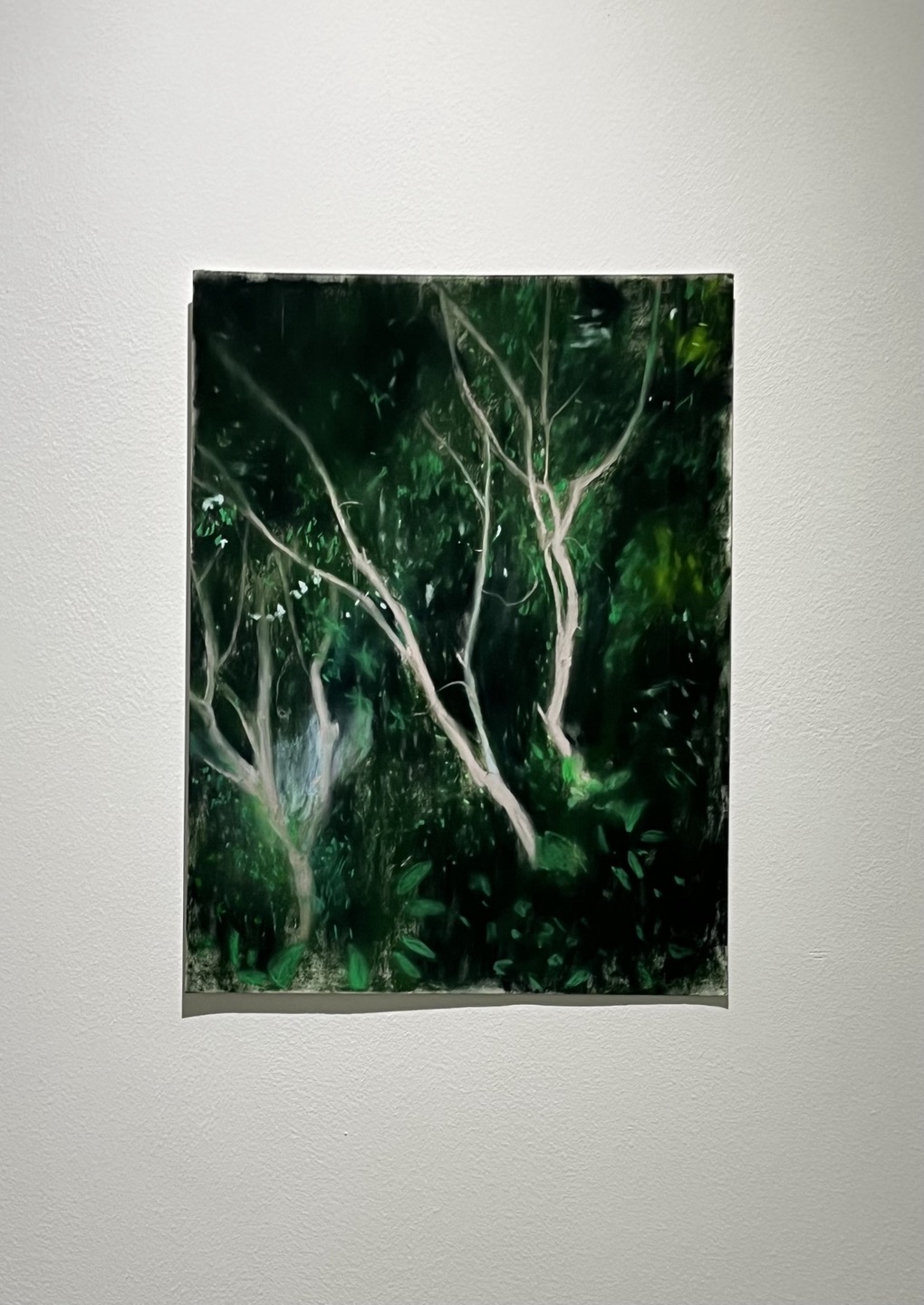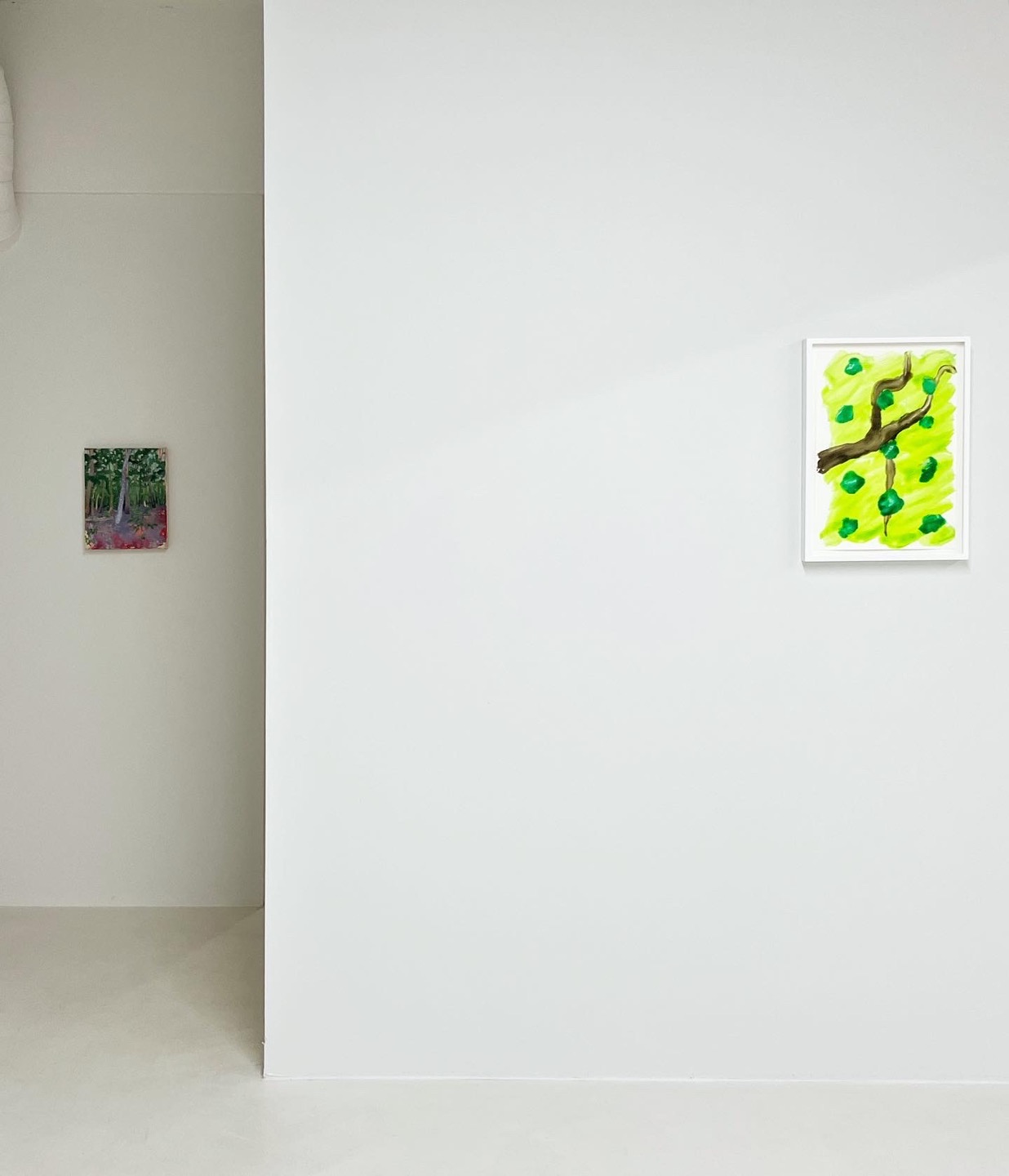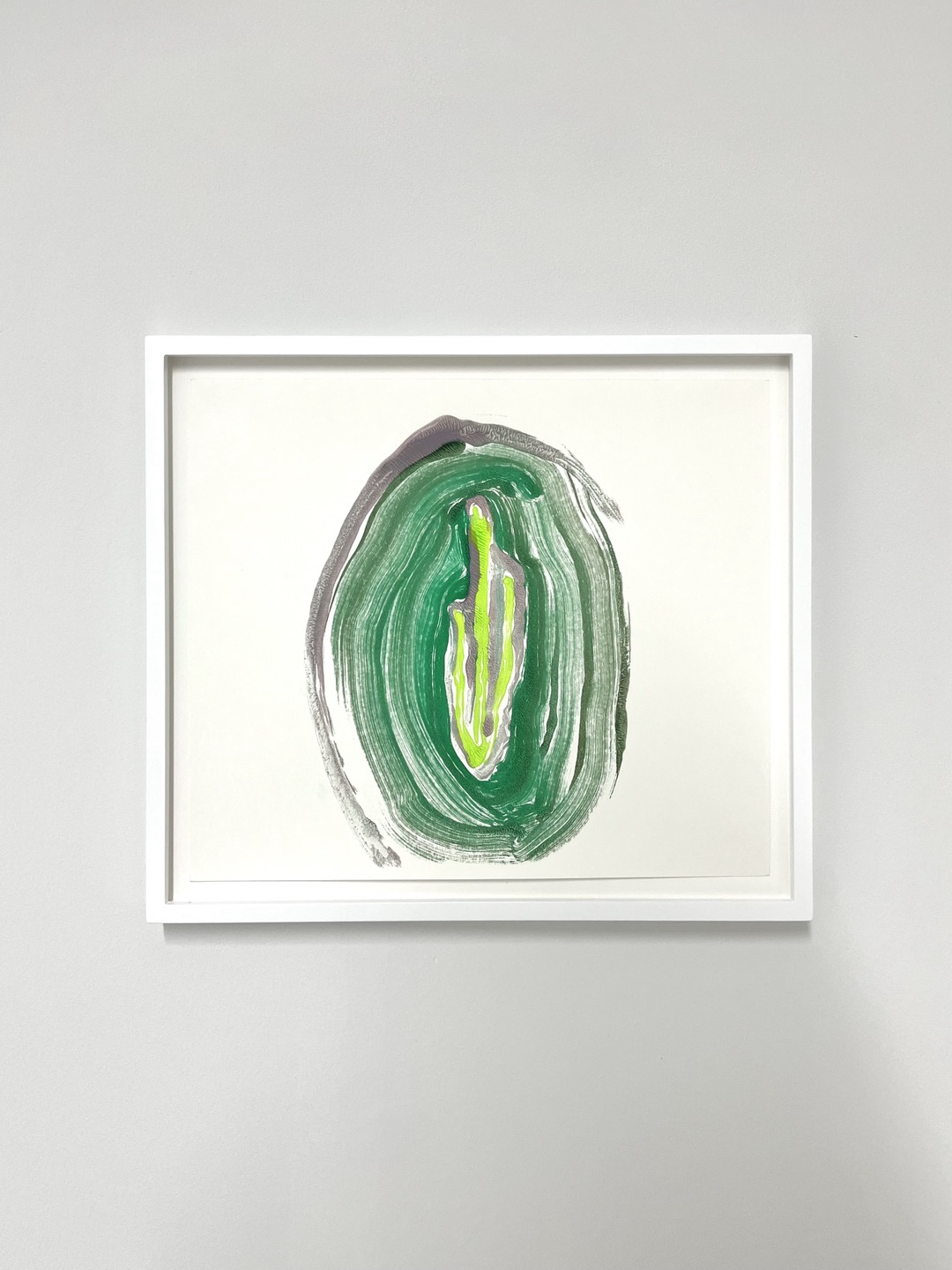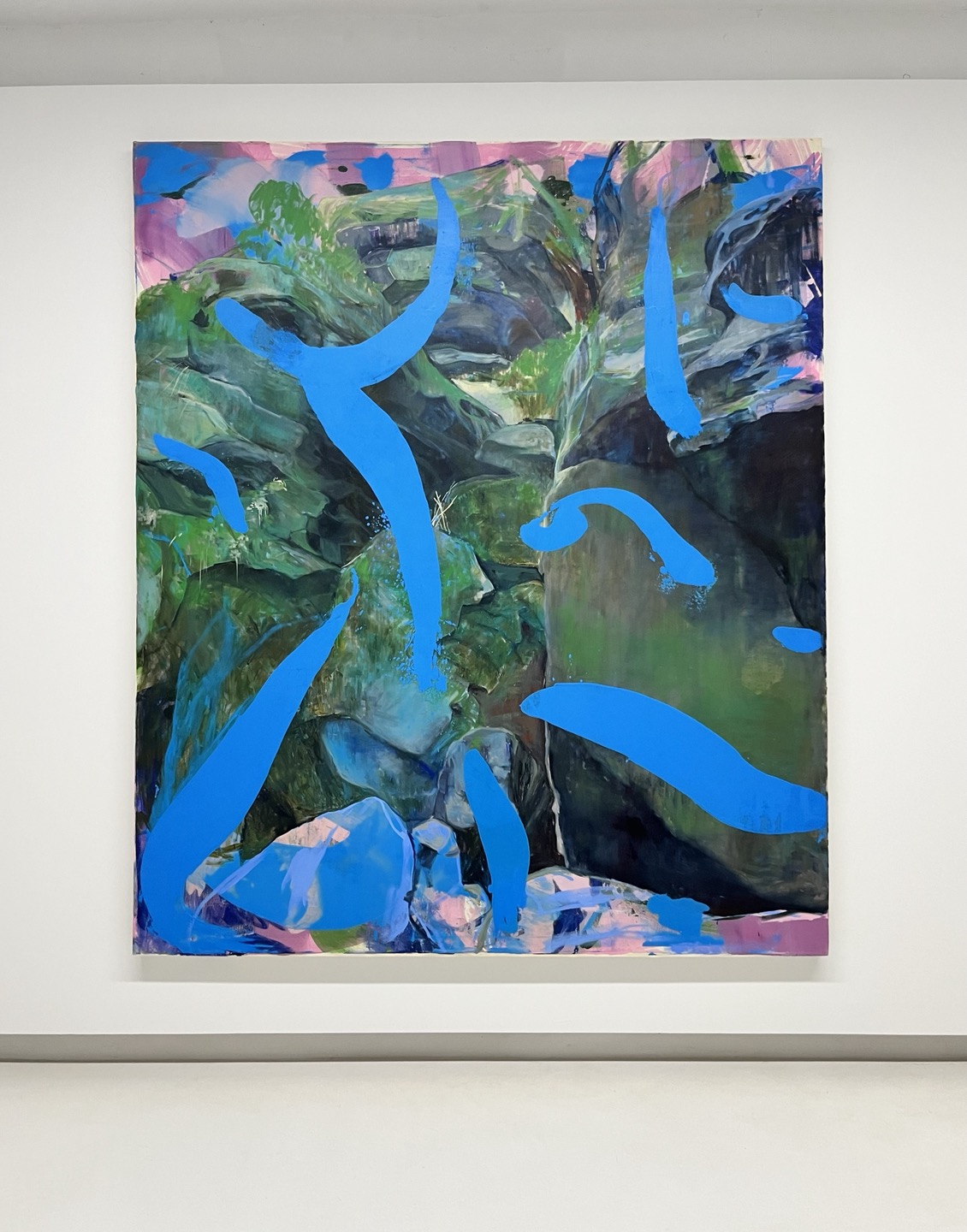
나무의_밤_trees_at_night,30x39cm,종이에파스텔,2020

installation_view1

박귀순, 봉오리_a_flower_bud,29x30cm,종이에_아크릴,모노토피,2018

박귀순,절벽_the_cliff,200x170cm,캔버스에_오일,2020.jpeg

installation_view2
숲 속으로
전시장 안에 걸린 초록색 톤의 그림들은 마치 숲을 향해 난 창문 같습니다. 울창한 숲처럼 어두운 명도로 캔버스를 가득 채운 나무들, 작은 폭포와 절벽이 보입니다. 어떤 그림에서는 흩뿌려진 빛의 조각처럼 반짝이는 잎사귀들 사이로 습기 어린 숲의 바람이 불어오는 것 같은 기분이 듭니다. 박귀순 작가의 이번 전시는 2018년 알테에고에서 열렸던 그의 이전 전시 「Nowhere and Everywhere」와 그 경향이 많이 다르다는 생각이 듭니다. 무엇이 달라졌을까요? 정말로 뭔가가 달라졌을까요? 작가의 작풍이 어느 순간 갑자기 크게 달라지는 일이 생긴다면, 그런 일은 대체 어떤 계기로 인해 생겨나는 것일까요? 그동안 있었던 강력한 외부적 요인이라면, 2019년부터 시작된 코로나 팬데믹이 있습니다. 그로 인한 급격하고 강제적인 변화들이 우리 모두의 일상에 엄청난 영향을 끼쳤다는 것을 누구도 부정할 수 없을 것입니다. 그의 그림에 갑작스레 등장한 울창한 숲의 이미지, 식물의 모티브들을 이런 맥락에서 생각해 본다면 어느 정도는 납득할 수가 있습니다. 이를테면 팬데믹으로 인한 각종 제한과 고립 속에서 조용하게 공원과 숲을 산책하는 일상은 어떤 식으로든 작가에게 새로운 종류의 영감을 주었을 테니까요. 그러다가 어느 날 문득, 이번 전시에서 우리가 만난 이 그림들은 자연을 주제로 한 완전히 새로운 초록의 가지를 힘차게 쭉 뻗어낸 것입니다. 비록 오래간만에 작품을 보게 된 우리에게는 깜짝 놀랄만한 일이 벌어진 셈이지만, 작가에게 이 모든 변화는 일상의 연장선상에서 진행된 것의 결과에 지나지 않을지도 모르겠습니다. 당연한 말이지만, 작가는 그냥 자신의 작업을 묵묵히 이어나갈 뿐이기 때문입니다. 그는 팬데믹 속에서도 늘 하던 대로 캔버스를 짜고, 성실하게 밑작업을 하고, 사용할 물감의 색들을 골랐을 것입니다. 숲의 이곳저곳을 찬찬히 관찰하면서 그것이 자신의 마음속에 어떤 감정을 일으키는지, 또 그것을 어떤 식으로 캔버스 위에서 회화적으로 표현해낼 수 있을지를 고민했을 것입니다. 물론 작가의 내부적 요인만으로도 작품은 갑자기 변할 수 있습니다. 그러나 감상자의 입장에서는 전혀 알기 어려운 부분이므로 그저 전시장에 걸린 그림을 통해 마음대로 추측해볼 수밖에 없겠습니다. 우선 박귀순 작가의 이전 그림들을 떠올려봅니다. 그의 그림들은 숨 막힐 듯 조용한 화면 안에서 차분하게 구축된 강한 긴장감을 가지고 있었습니다. 그 속에서 드러나는 서늘하고 관조적인 태도, 여운을 주는 심리적 파동 같은 것이 지배적인 인상으로 남아있습니다. 어느 장소든 그의 그림 속에 등장하는 곳은 작가의 관념적인 해석으로 재구성되어 의도적인 조명을 밝힌 연극 무대처럼 감상자의 시선을 붙잡아 머물게 했습니다. 그리고 몇 해의 시간이 흐르고 난 지금 이 그림들이 등장했습니다. 숲을 그린 그림입니다. 몇 개의 레이어를 가진 자연스러운 사생이지만, 불쑥 등장하는 색면의 추상적인 형태는 궁금증을 자아냅니다. 그런 요소들이 뒤섞여 있는 그림에서 작가는 무엇을 표현하려 한 것일까요? 하나의 단서처럼, 이 전시장의 입구에는 작가가 직접 쓴 작가 노트가 놓여 있습니다. 그림을 아주 좋아하는 반면 텍스트라는 것을 전혀 좋아하지 않는 사람이라면, (당신이 그림을 좋아하는 이유가 바로 ‘말’이 없어서라면) 좋아하는 작가의 작업 노트라고 하더라도 전혀 관심을 주지 않을 수도 있겠습니다. 아무튼 저는 거기에 그가 적어둔 글과 작품에 붙인 제목들을 읽어보고 작가의 직선적이고 꾸밈없는 태도에 어떤 호감을 느꼈습니다. 관찰일기의 제목 리스트 같은 짤막하고 간결한 작품 제목들에서도 작가의 한 단면을 짐작해봅니다. 그리고 결국엔 작가를 구성하는 이 모든 것들이 어느 순간 그의 그림들과 함께 어떤 완전한 설득력이라는 것을 만들어낼 수 있으리라 기대합니다.
/먹구름
(ENG)
Into the woods
The green paintings on the walls of the white exhibition room are like windows facing
the forest. You can find trees, small waterfalls, cliffs that fill the canvas as dark as in
dense forests. In some paintings, it feels like a damp forest breeze is blowing through
the twinkling leaves like scattered pieces of light.
I think this exhibition is very different from her previous exhibition 「Nowhere and
Everywhere」, which was presented at Alter ego in 2018. What has changed? Did
something really change? If the artist's style suddenly changes dramatically, how could
that happen.
For strong external factors that have occurred in the meantime, there is the COVID-19
pandemic that started in 2019. No one can deny that the drastic and forced changes
caused by the pandemic have had a tremendous impact on our daily lives. If you think
about the images of the forest, the plant motifs that suddenly appeared in her paintings
in this context, it's somewhat convincing. The daily life of walking quietly in parks and
forests amid various restrictions and isolation caused by the pandemic would have
inspired the artist in some way. And then one day, artist suddenly stretched out these
whole new green branch, these paintings that we met in this exhibition. Although it's a
surprise to us who haven't seen her work in a while, for the artist, all of this
transformation may be just the result of what's been going on in an extension of
everyday life. It's obvious, but she just keeps doing her work consistently. Even during
the pandemic, she would have stretched her canvas as usual, sized it with rabbit skin
glue and picked colors for her painting. She would have looked carefully at the forest
and wondered what kind of emotion it brings into her mind, and how she could paint
it on canvas.
Of course, the artist's internal factors alone can suddenly change the painting. But it's
something that's completely hard to understand from the perspective of the viewer, so
we have to guess just from the paintings in this exhibition room. First of all, let’s
think about Park Kui soon's previous paintings. Her paintings had a strong sense of
tension that was calmly constructed within a breathtakingly quiet image. The cool,
contemplative attitude and strange psychological waves that emerge in it remain the
dominant impression. Any place in her painting was reconstructed by the artist's
ideological interpretation. Such places caught the eyes of the viewer's and made them
stay as if they were intentionally illuminated theater stages. And now, after a few years,
these paintings have emerged. It's a painting of a forest. It's an ordinary landscape
painting with several layers, but the abstract form of the color bands that suddenly
appears raises curiosity. What was the artist trying to express in a painting like this
where those elements are mixed together?
As a clue, there is a note written by the artist at the entrance of this exhibition room.
If you're someone who loves painting but doesn't like text at all, (If the reason why
you like paintings is because they don't speak at all.) even if it's a piece of writing by
a favorite artist, it might not interest you at all. Anyway, after reading her writing and
the titles she gave to her paintings, I felt a certain liking for the artist's straight and
unadorned attitude. And I could guess the artist's taste from short and concise titles
such as the list of titles in the observation diary. In the end, I think all of these things
that make up the artist could at some point create some complete persuasion with her
paintings.
/Muggurum